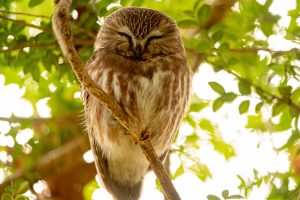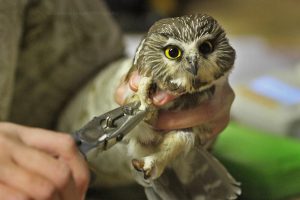A Big Journey for a Little Owl
Photos by Aaron Coolman, Mike McGraw and Celeste SheehanThe saw-whet owl will stop in Chester County this fall as it migrates south from Canada’s boreal forest.

Warning: The first time you see a northern saw-whet owl, you’ll be overwhelmed by its cuteness. The size of a soda can, the northern saw-whet is the smallest owl east of the Rockies, and with its minuscule stature and large eyes, it looks more like a living Beanie Baby or a Pixar-animated character than a wild creature. In tune with the latest neutral fashion trends, the saw-whet is covered in light brown feathers with white speckles on its wings and head, a white V-shaped eyebrow and matching white belly.
These little owls were thought by scientists to be so rare in the 1990s that they were nearly listed on the endangered species list and even graced “Conserve Wild Resources” license plates to draw attention to their perilous status. But, it turns out these birds are much more prolific than initially thought. Their small size, impeccable camouflage, secretive behaviors and nocturnal routine make them almost impossible to spot in the wild.
Autumn Visitors
Luckily for those of us living in Chester County, we can view these adorable creatures every fall as they make their long journey from the boreal forest of Canada to Pennsylvania, through the Mid-Atlantic, with some flying as far south as North Carolina for the winter.
One of the saw-whet owl’s favorite rest stops is Willistown Conservation Trust’s Rushton Farm and Rushton Woods Preserve. During the owls’ journey, which can span hundreds of miles, they’ll rest and feast on vermin. These autumn visitors like taking cover in the forest edges at Rushton Woods Preserve — a preferred type of hunting grounds where they can quickly and easily move from woodlands to clearings to catch mice and voles. Some of the owls may remain on the Preserve for weeks to months.
Project Owlnet

Since 2010, Willistown Conservation Trust’s (WCT) Bird Conservation Team has been tracking these owls when they visit in October and November. WCT’s bird scientists have set up an owl banding station as part of Project Owlnet, where they capture the owls in lengthy upright nets called “mist nets” and study them before releasing them back into the wild. The team tracks data including weight, wing measurements, sex and age.
To determine the age of a saw-whet owl, the trick is to observe its feathers. An older owl will have a mix of older and newer feathers, while an owl that’s hatched within the year will have new feathers that are uniform in color. The Bird Conservation Team uses a blacklight to observe the pigment of an owl’s feathers — older feathers appear white under the UV light, while newer feathers are a raspberry color because of a pigment called porphyrin.

If an owl caught in the mist nets doesn’t yet have a small metal band around its leg, the team will “band” it by placing on its leg a lightweight aluminum band inscribed with a unique nine-digit identification number. WCT’s banding station is one of over 100 throughout North America, where scientists can identify each unique bird that stops by and recreate a map of its migratory route. Through this cooperative tracking effort, scientists have learned these owls exist in many more places than originally thought.
Based on observations, the WCT teams have found most owls that visit our neck of the woods are females and young birds. Males often stay back in the boreal forest during winter months, so they can set up territories and prepare to woo potential female mates upon their return home.
Like any proper courtship, a male owl will win over a female with his beautiful serenades and thoughtful gifts. Males will sing the customary song that sounds like sharpening the teeth of a saw (giving the owl its name), and then leave dead mice or voles for their intended. When a female agrees to mate, she’ll sing in a soft voice, and then the two will perform a romantic duet to announce their union.
Changing Habitat
Sadly, the primary habitat of these stunning owls is at risk. The boreal forest comprises 25% of the world’s remaining intact forest — an area even larger than the Amazon rainforest — and it’s also considered to be the songbird nursery of North America. Yet this important forest area is under threat from climate change, oil and gas extraction, and logging operations, all of which put these owls’ lives in danger.
To help protect these special owls, consider doing the following:
- Choose post-recycled consumer paper products for your home.
- Decrease your junk mail by canceling and opting out of mailings.
- Reduce your grassy lawn by planting native plant species to attract birds.
- Conserve shrubland and woodland habitats.
- Keep your cats indoors.
- Avoid rodent poisons.
- Help migrating birds avoid hitting your windows by joining “Lights Out Philly.” Turn off outdoor lights at night during migration in fall (August 15 – November 15) and spring (April 1 – May 31).
This fall, especially around Halloween, keep an eye out for the visiting northern saw-whet owl. During the day, they like to roost high up in a tree or sometimes lower to the ground in shrubs. The owls also like to use nest boxes and trees with holes created by woodpeckers.
To search for these owls at night, find a location with a tree edge and clearing where they’re more likely to hunt. If you’re interested in learning more about WCT’s bird conservation efforts, check the website.
Willistown Conservation Trust focuses on 28,000 acres within the watersheds of Ridley, Crum and Darby Creeks of Chester and Delaware Counties. Since 1996, WCT has helped permanently conserve over 7,500 acres, including three nature preserves open to the public: Ashbridge, Kirkwood and Rushton Woods Preserve (home to Rushton Conservation Center and Rushton Farm). WCT offers activities for public engagement and research, including bird conservation, community farm, land protection, stewardship and watershed protection programs. More at WCTrust.org.
